spark MITSUBISHI COLT 2008 Owner's Manual (in English)
[x] Cancel search | Manufacturer: MITSUBISHI, Model Year: 2008, Model line: COLT, Model: MITSUBISHI COLT 2008Pages: 450, PDF Size: 14.57 MB
Page 23 of 450
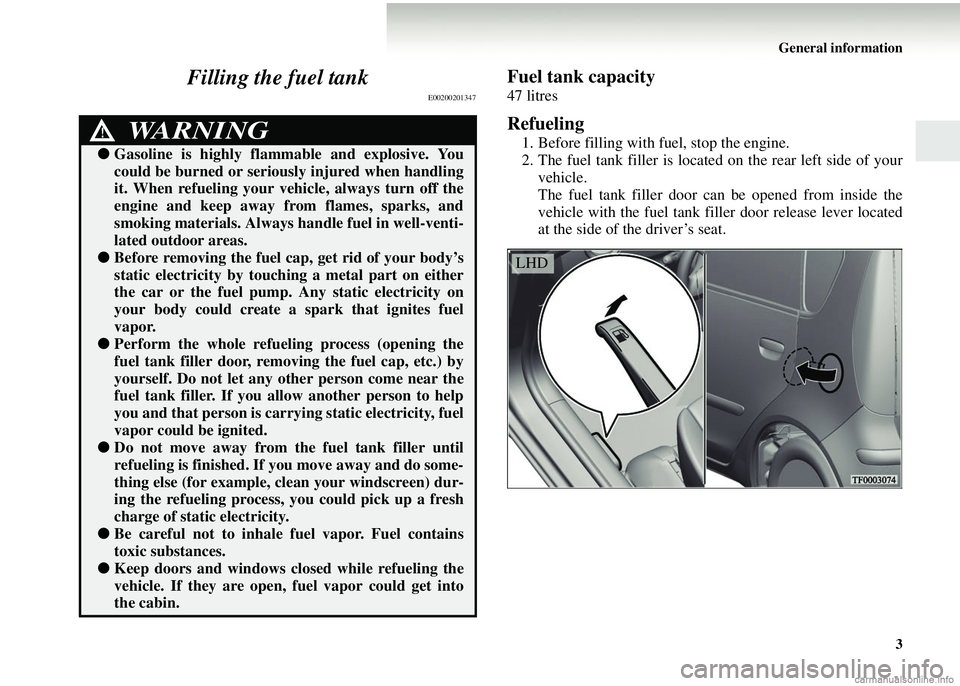
General information3
Filling the fuel tank
E00200201347
Fuel tank capacity
47 litres
Refueling
1. Before filling with fuel, stop the engine.
2. The fuel tank filler is located on the rear left side of yourvehicle.
The fuel tank filler door can be opened from inside the
vehicle with the fuel tank filler door release lever located
at the side of the driver’s seat.WARNING!
● Gasoline is highly flammable and explosive. You
could be burned or seriously injured when handling
it. When refueling your vehicle, always turn off the
engine and keep away from flames, sparks, and
smoking materials. Always ha ndle fuel in well-venti-
lated outdoor areas.
● Before removing the fuel cap, get rid of your body’s
static electricity by touchi ng a metal part on either
the car or the fuel pump. Any static electricity on
your body could create a spark that ignites fuel
vapor.
● Perform the whole refueling process (opening the
fuel tank filler door, removing the fuel cap, etc.) by
yourself. Do not let any other person come near the
fuel tank filler. If you allow another person to help
you and that person is carrying static electricity, fuel
vapor could be ignited.
●Do not move away from the fuel tank filler until
refueling is finished. If you move away and do some-
thing else (for example, clean your windscreen) dur-
ing the refueling process, you could pick up a fresh
charge of static electricity.
●Be careful not to inhale fuel vapor. Fuel contains
toxic substances.
● Keep doors and windows cl osed while refueling the
vehicle. If they are open , fuel vapor could get into
the cabin.
LHD
Page 293 of 450
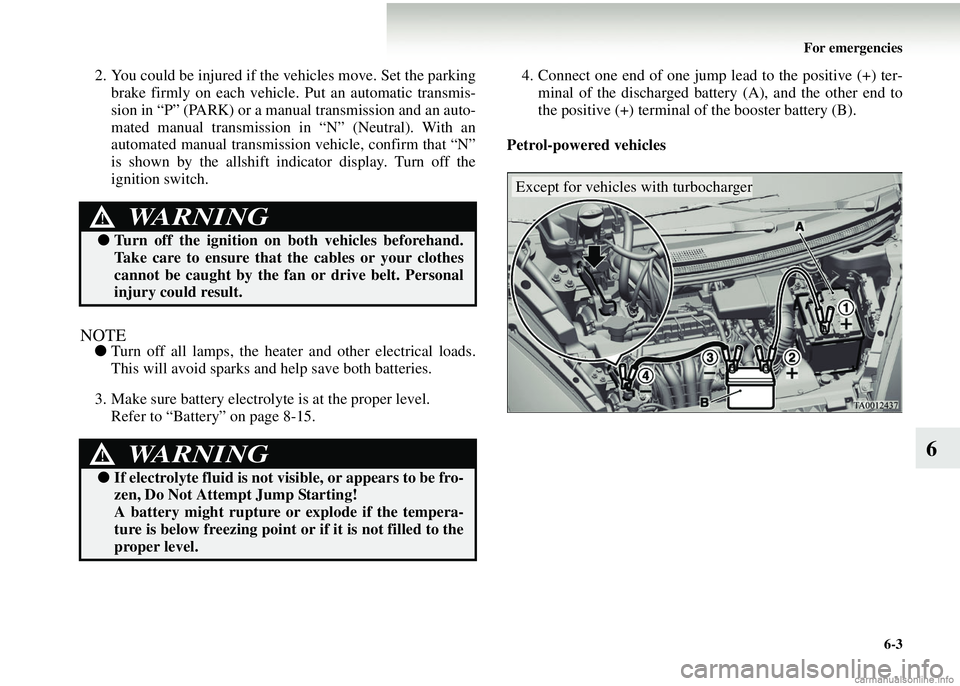
For emergencies6-3
6
2. You could be injured if the vehicles move. Set the parkingbrake firmly on each vehicle. Put an automatic transmis-
sion in “P” (PARK) or a manua l transmission and an auto-
mated manual transmission in “N” (Neutral). With an
automated manual transmission vehicle, confirm that “N”
is shown by the allshift indicator display. Turn off the
ignition switch.
NOTE● Turn off all lamps, the heater and other electrical loads.
This will avoid sparks and help save both batteries.
3. Make sure battery electrolyte is at the proper level. Refer to “Battery” on page 8-15. 4. Connect one end of one jump lead to the positive (+) ter-
minal of the discharged battery (A), and the other end to
the positive (+) terminal of the booster battery (B).
Petrol-powered vehicles
WARNING!
● Turn off the ignition on both vehicles beforehand.
Take care to ensure that the cables or your clothes
cannot be caught by the fan or drive belt. Personal
injury could result.
WARNING!
● If electrolyte fluid is not vi sible, or appears to be fro-
zen, Do Not Attempt Jump Starting!
A battery might rupture or explode if the tempera-
ture is below freezing point or if it is not filled to the
proper level.
Except for vehicles with turbocharger
Page 295 of 450
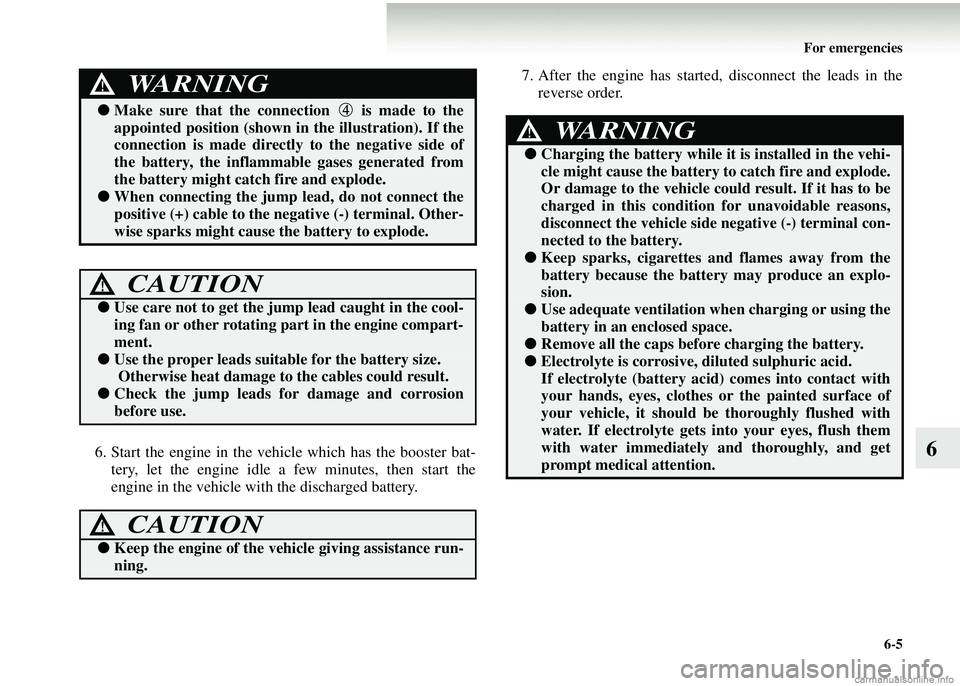
For emergencies6-5
66. Start the engine in the vehicle which has the booster bat-tery, let the engine idle a few minutes, then start the
engine in the vehicle with the discharged battery. 7. After the engine has started, disconnect the leads in the
reverse order.
● Make sure that the conn ection is made to the
appointed position (shown in the illustration). If the
connection is made directly to the negative side of
the battery, the inflammable gases generated from
the battery might catch fire and explode.
● When connecting the jump lead, do not connect the
positive (+) cable to the ne gative (-) terminal. Other-
wise sparks might cause the battery to explode.
CAUTION!
●Use care not to get the jump lead caught in the cool-
ing fan or other rotating part in the engine compart-
ment.
● Use the proper leads suitable for the battery size.
Otherwise heat damage to the cables could result.
●Check the jump leads for damage and corrosion
before use.
CAUTION!
●Keep the engine of the ve hicle giving assistance run-
ning.
WARNING!
WARNING!
● Charging the battery while it is installed in the vehi-
cle might cause the battery to catch fire and explode.
Or damage to the vehicle could result. If it has to be
charged in this condition for unavoidable reasons,
disconnect the vehicle side negative (-) terminal con-
nected to the battery.
● Keep sparks, cigarettes an d flames away from the
battery because the battery may produce an explo-
sion.
● Use adequate ventilation when charging or using the
battery in an enclosed space.
●Remove all the caps before charging the battery.
●Electrolyte is corrosive, diluted sulphuric acid.
If electrolyte (battery ac id) comes into contact with
your hands, eyes, clothes or the painted surface of
your vehicle, it should be thoroughly flushed with
water. If electrolyte gets into your eyes, flush them
with water immediately and thoroughly, and get
prompt medical attention.
Page 344 of 450
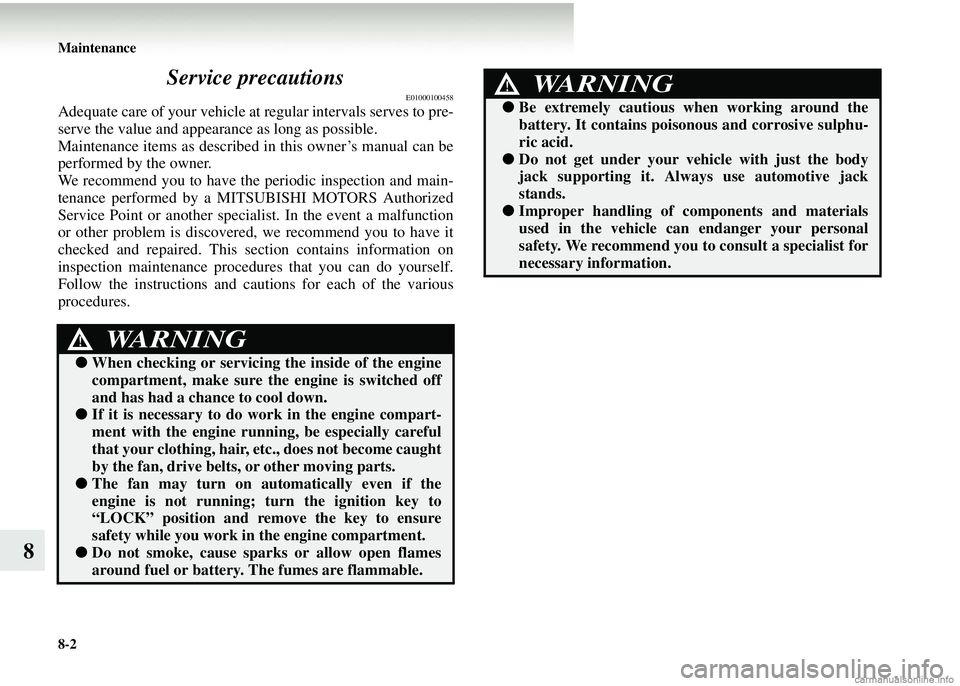
8-2 Maintenance
8Service precautions
E01000100458
Adequate care of your vehicle at
regular intervals serves to pre-
serve the value and appear ance as long as possible.
Maintenance items as described in this owner’s manual can be
performed by the owner.
We recommend you to have the periodic inspection and main-
tenance performed by a MITS UBISHI MOTORS Authorized
Service Point or another specialist. In the event a malfunction
or other problem is discovered, we recommend you to have it
checked and repaired. This section contains information on
inspection maintenance procedures that you can do yourself.
Follow the instructions and cautions for each of the various
procedures.
WARNING!
● When checking or servicing the inside of the engine
compartment, make sure th e engine is switched off
and has had a chan ce to cool down.
●If it is necessary to do work in the engine compart-
ment with the engine runni ng, be especially careful
that your clothing, hair, et c., does not become caught
by the fan, drive belts, or other moving parts.
● The fan may turn on automatically even if the
engine is not running; turn the ignition key to
“LOCK” position and remove the key to ensure
safety while you work in the engine compartment.
●Do not smoke, cause sparks or allow open flames
around fuel or battery. The fumes are flammable.
●Be extremely cautious wh en working around the
battery. It contains poison ous and corrosive sulphu-
ric acid.
● Do not get under your vehicle with just the body
jack supporting it. Always use automotive jack
stands.
●Improper handling of comp onents and materials
used in the vehicle can endanger your personal
safety. We recommend you to consult a specialist for
necessary information.
WARNING!
Page 345 of 450
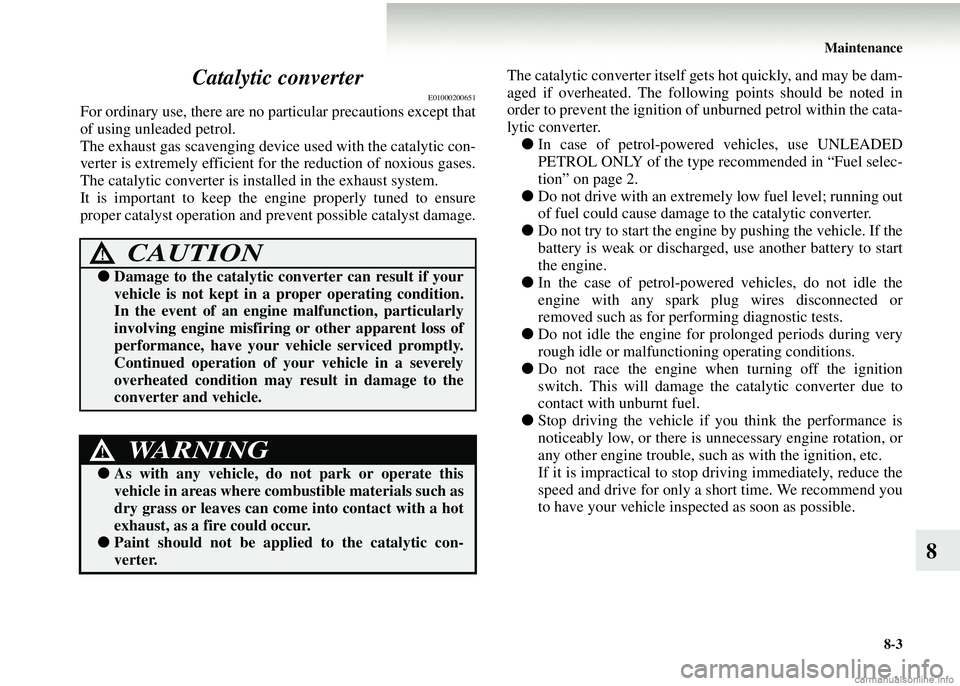
Maintenance8-3
8
Catalytic converter
E01000200651
For ordinary use, there are no
particular precautions except that
of using unleaded petrol.
The exhaust gas scavenging device used with the catalytic con-
verter is extremely ef ficient for the reduction of noxious gases.
The catalytic converter is inst alled in the exhaust system.
It is important to keep the engine properly tuned to ensure
proper catalyst operation and prevent po ssible catalyst damage. The catalytic converter itself gets hot quickly, and may be dam-
aged if overheated. The followi
ng points should be noted in
order to prevent the ignition of unburned petrol within the cata-
lytic converter. ● In case of petrol-powered vehicles, use UNLEADED
PETROL ONLY of the type recommended in “Fuel selec-
tion” on page 2.
● Do not drive with an extremely low fuel level; running out
of fuel could cause damage to the catalytic converter.
● Do not try to start the engine by pushing the vehicle. If the
battery is weak or discharged, use another battery to start
the engine.
● In the case of petrol-powered vehicles, do not idle the
engine with any spark plug wires disconnected or
removed such as for performing diagnostic tests.
● Do not idle the engine for prolonged periods during very
rough idle or malfunctioning operating conditions.
● Do not race the engine when turning off the ignition
switch. This will damage the catalytic converter due to
contact with unburnt fuel.
● Stop driving the vehicle if you think the performance is
noticeably low, or there is un necessary engine rotation, or
any other engine trouble, such as with the ignition, etc.
If it is impractical to stop driving immediately, reduce the
speed and drive for only a s hort time. We recommend you
to have your vehicle inspected as soon as possible.
CAUTION!
● Damage to the catalytic co nverter can result if your
vehicle is not kept in a proper operating condition.
In the event of an engine malfunction, particularly
involving engine misfiring or other apparent loss of
performance, have your vehicle serviced promptly.
Continued operation of your vehicle in a severely
overheated condition may re sult in damage to the
converter and vehicle.
WARNING!
● As with any vehicle, do not park or operate this
vehicle in areas where combustible materials such as
dry grass or leaves can come into contact with a hot
exhaust, as a fire could occur.
●Paint should not be applied to the catalytic con-
verter.
Page 360 of 450
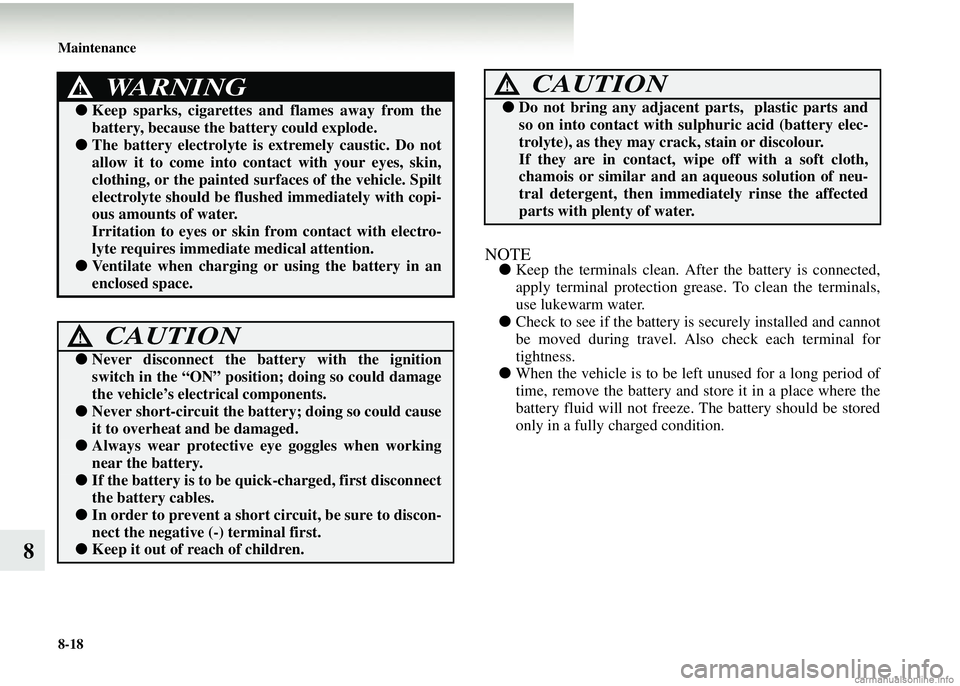
8-18 Maintenance
8
NOTE●Keep the terminals clean. Afte r the battery is connected,
apply terminal protection grease. To clean the terminals,
use lukewarm water.
● Check to see if the battery is securely installed and cannot
be moved during travel. Also check each terminal for
tightness.
● When the vehicle is to be left unused for a long period of
time, remove the battery and store it in a place where the
battery fluid will not freeze. Th e battery should be stored
only in a fully charged condition.
WARNING!
● Keep sparks, cigarettes and flames away from the
battery, because the ba ttery could explode.
●The battery electrolyte is extremely caustic. Do not
allow it to come into cont act with your eyes, skin,
clothing, or the painted surf aces of the vehicle. Spilt
electrolyte should be flus hed immediately with copi-
ous amounts of water.
Irritation to eyes or skin from contact with electro-
lyte requires immediate medical attention.
● Ventilate when charging or using the battery in an
enclosed space.
CAUTION!
● Never disconnect the ba ttery with the ignition
switch in the “ON” position; doing so could damage
the vehicle’s electrical components.
● Never short-circuit the battery; doing so could cause
it to overheat and be damaged.
●Always wear protective eye goggles when working
near the battery.
●If the battery is to be qui ck-charged, first disconnect
the battery cables.
● In order to prevent a short ci rcuit, be sure to discon-
nect the negative (-) terminal first.
●Keep it out of re ach of children.
●Do not bring any adjacent pa rts, plastic parts and
so on into contact with su lphuric acid (battery elec-
trolyte), as they may cra ck, stain or discolour.
If they are in contact, wipe off with a soft cloth,
chamois or similar and an aqueous solution of neu-
tral detergent, then imme diately rinse the affected
parts with plenty of water.
CAUTION!
Page 426 of 450
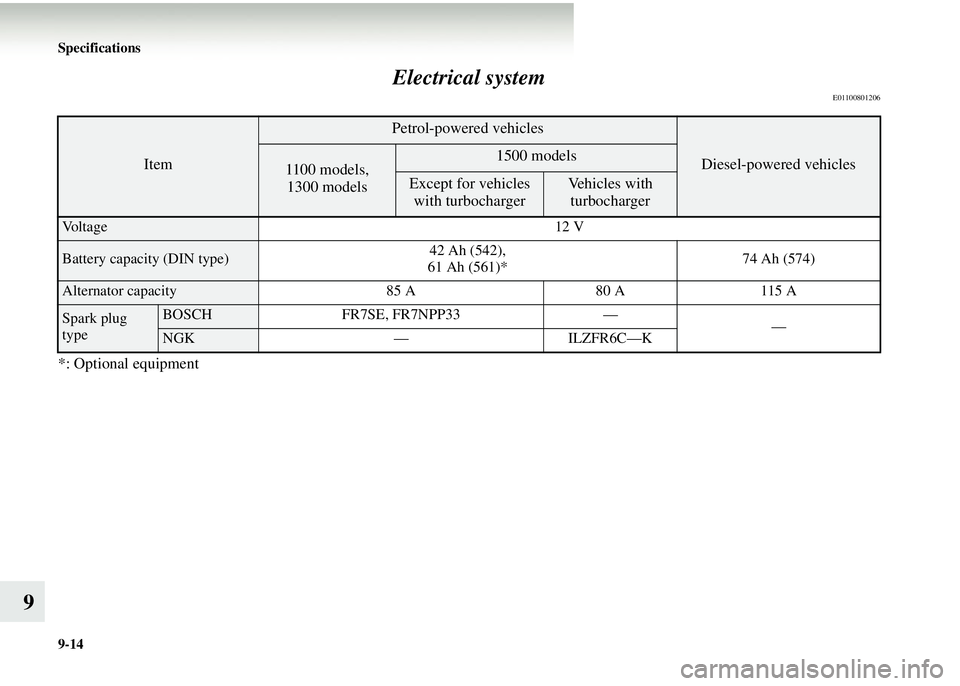
9-14 Specifications
9Electrical system
E01100801206
*: Optional equipment
Item
Petrol-powered vehicles
Diesel-powered vehicles1100 models,
1300 models1500 models
Except for vehicles with turbochargerVehicles withturbocharger
Voltage 12 V
Battery capacity (DIN type)42 Ah (542),
61 Ah (561)* 74 Ah (574)
Alternator capacity
85 A80 A115 A
Spark plug
typeBOSCH FR7SE, FR7NPP33 —
—
NGK —ILZFR6C—K
Page 441 of 450
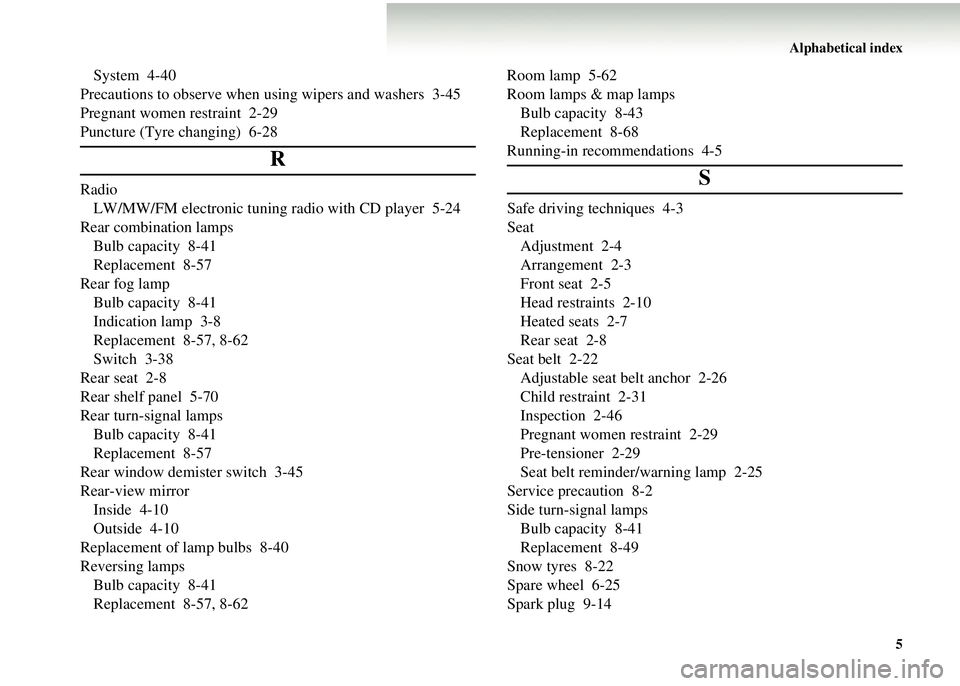
Alphabetical index5
System 4-40
Precautions to observe when using wipers and washers 3-45
Pregnant women restraint 2-29
Puncture (Tyre changing) 6-28
R
Radio LW/MW/FM electronic tuning radio with CD player 5-24
Rear combination lamps Bulb capacity 8-41
Replacement 8-57
Rear fog lamp Bulb capacity 8-41
Indication lamp 3-8
Replacement 8-57, 8-62
Switch 3-38
Rear seat 2-8
Rear shelf panel 5-70
Rear turn-signal lamps Bulb capacity 8-41
Replacement 8-57
Rear window demister switch 3-45
Rear-view mirror Inside 4-10
Outside 4-10
Replacement of lamp bulbs 8-40
Reversing lamps Bulb capacity 8-41
Replacement 8-57, 8-62 Room lamp 5-62
Room lamps & map lamps
Bulb capacity 8-43
Replacement 8-68
Running-in recommendations 4-5S
Safe driving techniques 4-3
Seat Adjustment 2-4
Arrangement 2-3
Front seat 2-5
Head restraints 2-10
Heated seats 2-7
Rear seat 2-8
Seat belt 2-22 Adjustable seat belt anchor 2-26
Child restraint 2-31
Inspection 2-46
Pregnant women restraint 2-29
Pre-tensioner 2-29
Seat belt reminder/warning lamp 2-25
Service precaution 8-2
Side turn-signal lamps Bulb capacity 8-41
Replacement 8-49
Snow tyres 8-22
Spare wheel 6-25
Spark plug 9-14